
RESULTS OF PALEOMAGNETIC STUDY ON JURASSIC SANDSTONE AND SILTSTONE OF THE HÀ CỐI FORMATION AND THEIR TECTONIC IMPLICATIONS
CUNG THƯỢNG CHÍ
Geologycal Institute of Geology, NCNST, Hoàng Quốc Việt, Cầu Giấy, Hà Nội
Abstract: Thirteen paleomagnetic sampling localities with 111 oriented drill cores have been gathered from continental red sandstone and siltstone of the Lower-Middle Jurassic Hà Cối Formation, along the Highway No.18 from Tiên Yên to Móng Cái. The characteristic remanent magnetization is carried by hematite which has the mean magnetic declination DS = 2.3o, magnetic inclination IS = 46o, a 95 = 8.3o, that corresponds to the paleomagnetic pole located in the coordinates: l = 83.1o N, f = 117.9o E. The magnetic character of hematite is not of primary origin, but this mineral was remagnetized when the formation was folded, possibly during Late Jurassic - Cretaceous period. Results of paleomagnetic study on siltstone and sandstone of the Hà Cối Formation have been showing that the sampled area did not rotate and displace significantly in latitude in comparison with Northwest Việt Nam, at the same time it rotated Counter-clockwise with an angle of 14.6o in comparison with South Việt Nam. This Counter-clockwise rotation has been recorded also in Upper Jurassic - Cretaceous effusive-intrusive formations of Northwest Việt Nam and in Lower-Middle Jurassic red beds of South China, that is, probably, related to tectonic movement of the sinistral strike-slip NW-SE trending fault system.
LOCALITIES OF PALEOMAGNETIC SAMPLING
In Northeast Việt Nam, Jurassic continental red beds of the Hà Cối Formation are largely distributed in the Tiên Yên, Quảng Ninh, Hà Cối and Móng Cái areas of the coastal zone, with a thickness of 400-2500 m, lying unconformably upon Lower Paleozoic sediments and Norian-Rhaetian coal-bearing formation. These Jurassic continental sediments are characterized by thick member of quartz conglomerate at the base, that grades upward to violet-red, dark red irregular-grained sandstone, violet-red siltstone, red-yellow claystone and, locally, marl arranged in the alluvial rhythm structure. In sandstone, the fragments consist mainly of quartz, feldspar, carbonate with the cement from clay, carbonate and ferrous hydroxide [7]. Siltstone is interbedded with thin lenses of coaly shale or coal in the lower part of the member, bearing relatively rare flora fossils, such as Coniopteris sp., Equisetites sp. etc. [9]. The Hà Cối continental red beds has been correlated with the Thọ Lâm Group in Central Việt Nam, and the Bản Đôn Group in South Việt Nam bearing fossils of marine mollusc of Sinemurian-Bajocian age (Early-Middle Jurassic). It has been correlated also with the Phra Wihan and Phu Kradung Formations from the Khorat Plateau, Thailand [10].
The paleomagnetic sampling has been carried out in the above mentioned formation in 13 localities lying along the Highway No.18 from Tiên Yên to Móng Cái, where 111 oriented drill cores were collected mainly from violet-red silty sandstone (Fig.1). In these localities, the
Table 1. Results of paleomagnetic measurement of Jurassic Hà Cối Formation from NE Việt Nam

Note: Lat.: latitude; Long.: longitude; sd, sandst: sandstone; sts, siltst: siltstone; St: strike of the bedding surface; Dp: dip of the bedding surface; n: number of samples used in the calculation of mean value; N: total number of measured samples; Dg (Ig): declination (inclination) in the present geographic coordinates; Ds (Is): declination (inclination) in the paleogeographic coordinates (after adjustment of tectonic attitude); a 95 (A95): reliable error at 95%; k: parameter of accuracy; l g (f g): latitude (longitude) of the paleomagnetic pole in the present geographic coordinates; l s (f s): latitude (longitude) of the paleomagnetic pole in paleogeographic coordinates.
beds have distinct bedding attitude. Except for 4 localities where the dip of the beds is large with the folding axis of N-S trend, the others have small dip of about < 30o with the folding axis of NE-SW trend (Table 1).
The samples have been taken in accordance to given regulations [2]. They were analyzed and measured in the Paleomagnetic Laboratory of the Academy of Sciences of Taiwan (sample number: 9706-9711), and in the Paleomagnetic Laboratory of the National Institute of Geology and Mineral Resources of Poland (remaining samples).
RESULTS OF PALEOMAGNETIC STUDY
The natural remanent magnetization of samples from Hà Cối sandstone and siltstone has the intensity varying from 0.5 ´ 10-3 mA/m to 2.0 ´ 10-2 mA/m, carried mainly by hematite characterized by the Curie point of 675oC. The method of thermal demagnetization is very effective for these sandstone and siltstone samples, allowing to separate two components of remanent magnetization in the samples.
During the process of thermal demagnetization, the magnetic susceptibility of representative samples of the localities have been measured at each step of the heating temperature for monitoring the alteration of magnetic mineral phases (Fig.2). The magnetic susceptibility of almost all Jurassic Hà Cối sandstone and siltstone samples has the value varying within the interval of 2-6 ´ 10-6 SI that is relatively stable during the process of sample heating to the temperature of 620oC, then this value begins to increase gradually together with the increase of the heating temperature.
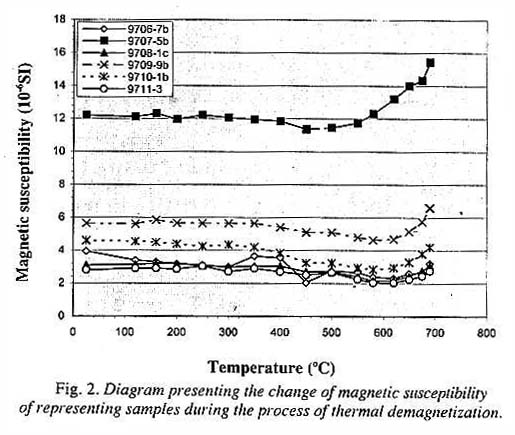
The Zijderveld orthogonal projection of the components of natural remanent magnetization vector in the process of thermal demagnetization of some characteristic samples is presented in the Fig.3. The components of secondary remanent magnetization are separated and annulled in the temperature of 350-400o C, the components of characteristic remanent magnetization converge in a stable direction to the coordinate base in a higher heating temperature.
The mean paleomagnetic direction of the remanent magnetization characterizing each sampled locality is presented in the projection of the equal area (Fig.4) and the values are listed in the Table 1. The average value of 13 localities before adjusting the tectonic attitude consists of Dg = 347.0o; Ig = 35.9o; a 95 = 7.7; kg = 29.9; and after this: Ds = 2.3o; Is = 46.0o; a 95 = 8.3; ks = 25.6; corresponding to the paleomagnetic pole which has the following coordinates: l = 83.1o N and f = 117.9o E, A95 = 9.1. These data have been showing that after adjusting the tectonic attitude, the error a 95 increases and the precise parameter k decreases (ks/kg = 0.86), it means the fold test failed. This has been indicating that the remanent magnetization of Hà Cối sandstone and siltstone samples is not primary one, but it was formed during or after the folding process of the Hà Cối siltstone and sandstone. The author of this paper has tried to use different analyzing methods (Inclination-only analysis, Block rotation Fischer analysis, and Syntilting Fischer analysis) for determining the relative age of these characteristic components of remanent magnetization. The results have been showing that the characteristic components of remanent magnetization of the Hà Cối sandstone and siltstone samples was formed in the time interval between fold processes (kmax = 104.5, and a 95min = 4.1 are achieved at 50% of an folding process.
So, even if these are not components of primary remanent magnetization, but anyhow we can know that the forming time of this paleomagnetic direction coincides with the folding time of the Jurassic Hà Cối Formation. During the Middle Jurassic - Cretaceous period the tectono-magmatic - orogenic activities happened strongly in the East and Southeast of Asia related to the subduction of Paleo-Pacific Plate under the Eurasia Plate [1, 5, 6, 8]. In China, these tectonic activities have been named as Yenshanian orogeny, at the same time in Việt Nam volcano-plutonic and volcano-sedimentary formations were created in the Tú Lệ, An Châu Depressions in the North, and Đŕ Lạt Depression in the South causing the folding of older geological formations. So, it is very possible that the characteristic components of remanent magnetization of the Hà Cối sandstone and siltstone have a late Jurassic - early Cretaceous age.

Note: Obs. VGP: paleomagnetic pole determined from study on rocks; Ref. VGP: standard paleomagnetic pole of Eurasia [Besse & Courtillot, 1991]; R: clockwise (+) and anticlockwise (-) rotation; D l : displacement in latitude northward (+) or southward (-). Study results on Shan-Thai and Indochina Blocks have been compared with standard paleomagnetic pole of Eurasia (1st row) and with paleomagnetic pole of S China Block (2nd row).
References: 1) Lin, 1984; 2) Elkin et al, 1991; 3) Zhu et al, 1988; 4) Huang & Opdyke, 1993; 5) Kim & V.D. Voo, 1990; 6) Yang et al, 1995; 7) Gilder et al, 1993; 8) This paper.
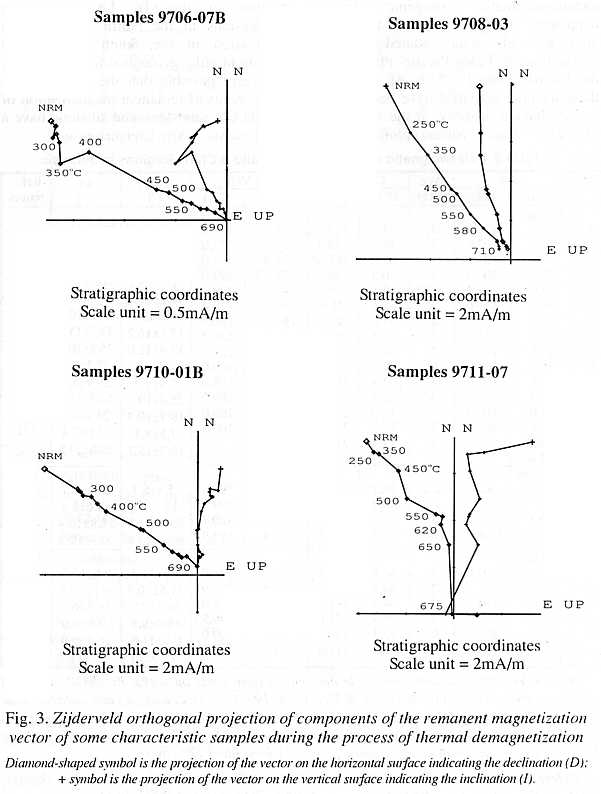
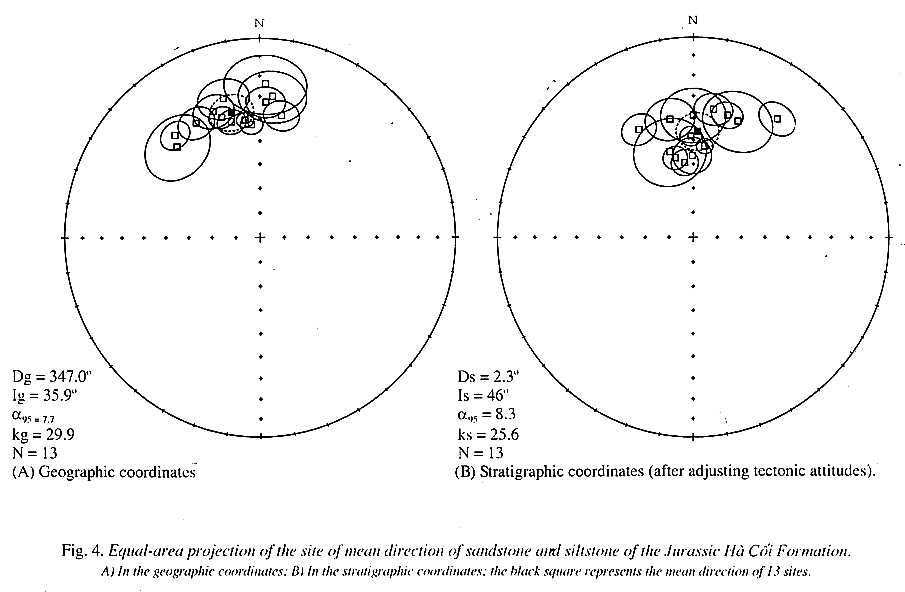
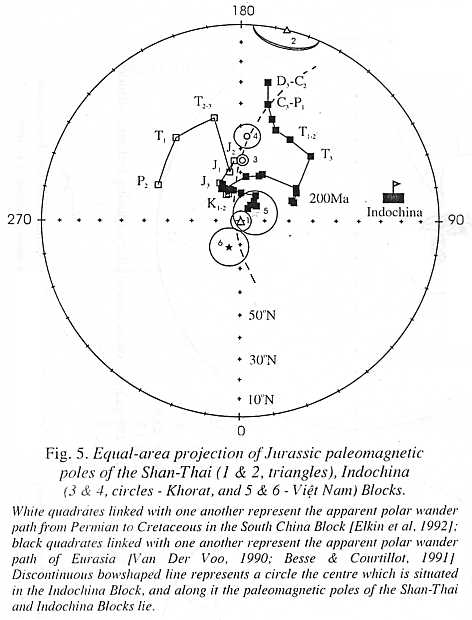
TECTONIC INTERPRETATION
The use of the paleomagnetic pole of Upper Jurassic - Cretaceous formations in Northwest Việt Nam (l = 86.4o N; f = 235.2o E) allows us to determine the parameters of rotation and translation as: R = -1.6o ± 10.6o and D l = -9.0o ± 9.7o. These values indicate that the Jurassic Hà Cối Formation in NE Việt Nam was not subjected to a rotation, nor moved considerably in latitude in comparing with the NW region since post-Cretaceous period. Similarly, using the paleomagnetic pole of Upper Jurassic - Cretaceous formations in South Việt Nam (l = 74.2o N; f = 171.1o E) we have R = -14.6o ± 9.8o and D l = -0.5o ± 8.6o. Thus, we can see that in comparing with South Việt Nam the Jurassic Hà Cối Formation was subjected to a counter -clockwise rotation with an angle of 14.6o, but not to a displacement in latitude; this corresponds also to the results of paleomagnetic study on Upper Jurassic - Cretaceous formations in NW Việt Nam. The results are also similar, when comparing with Cretaceous paleomagnetic pole of the South China Block (l = 75.9o N; f = 211.5o E) we have R = -13o ± 12o and D l = -10.8o ± 10.9o. The counter -clockwise rotation of Mesozoic geological formations from North Việt Nam in comparing with geological formations of the same age from South Việt Nam has been recognized in Upper Jurassic - Cretaceous effusive-intrusive rocks from NW Việt Nam [3]. Gilder et al [4] in their paleomagnetic study on Jurassic continental red beds from the south of Guangsi Province, China (in 150 km northeast of Móng Cái) have been recognizing the counter -clockwise rotation in these Jurassic continental red beds, that has been interpreted as related to sinistral strike-slip of the NW-SE trending fault system. So, the anomaly of paleomagnetic direction of the Jurassic Hà Cối Formation conforms also to the research results in China, and reflects a local tectonic rotation, that may be related to the NW-SE trending strike-slip fault system, including the Cao Bằng - Tiên Yên Fault.
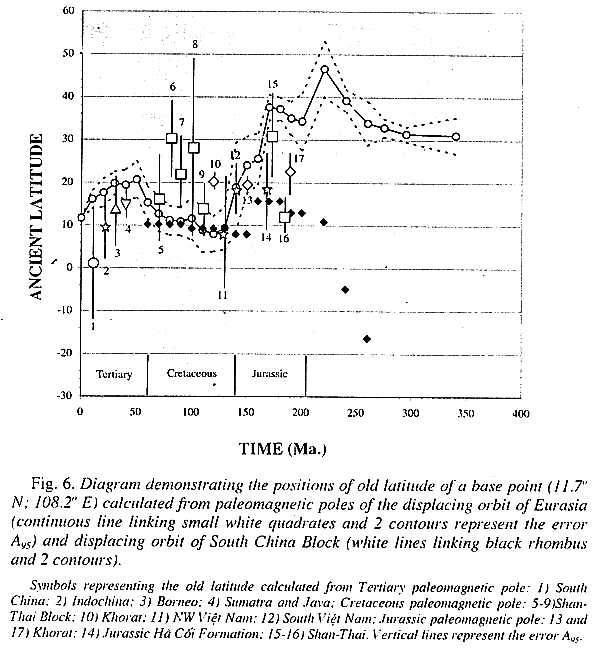
Paleomagnetic data from SE Asia and S China regions during Jurassic period have been collected from geological litterature and listed in the Table 2. These results have been showing clearly that before the Late Jurassic period, the paleogeographic position of South China, Shan-Thai and Indochina Blocks was situated in the south of Eurasia Continent and subjected to a clockwise rotation. However, paleomagnetic data of the Late Jurassic period have been proving that during this period South China was completely amalgamated with or situated very near to Eurasia (Fig.6). So, it is clear that before Late Jurassic period the South China Block was on its northward drifting voyage and, at the same time rotated clockwise for approaching Eurasia during the Late Jurassic - Early Cretaceous time.
On the other hand, results of paleomagnetic study on Lower-Middle Jurassic sedimentary formations from Shan-Thai and Indochina Blocks have been showing also the correlation on geographic space between these two blocks and the South China Block; the values of D l have been showing that the Shan-Thai and Indochina Blocks might be amalgamated with the South China Block just before Early-Middle Jurassic time [6]. The dispersion of R values and the tendency of distribution along a small circle of paleomagnetic poles with the centre situated in the Shan-Thai - Indochina Block (Fig.5) have been reflecting the influencing role of local tectonic rotation which was caused by complex folding and faulting.
CONCLUSION
The results of paleomagnetic study on Jurassic Hà Cối sandstone and siltstone have been allowing us to draw some following conclusions:
1) Characteristic paleomagnetic direction carried by hematite from Jurassic Hà Cối sandstone and siltstone is not of primary origin, but appeared during the folding process, maybe, in Late Jurassic - Cretaceous period.
2) Jurassic Hà Cối sandstone and siltstone from NE Việt Nam was not subjected to rotation or significant displacement in comparing with NW Việt Nam in the post-Cretaceous period.
3) The Hà Cối sandstone and siltstone formation from NE Việt Nam was subjected to counter - clockwise rotation with an angle of 14.6o in comparing with South Việt Nam region.
4) The counter - clockwise rotation of Jurassic-Cretaceous geological formations from NE, NW Việt Nam and Guangsi regions, China, reflected through paleomagnetic data, might be caused by activities of sinistral strike-slip fault system of NW-SE trend, under a "ball-rotation" mechanism around a vertical axis.
5) Before Late Jurassic period, the South China, Shan-Thai and Indochina lithosphere blocks were amalgamated with one another, lying in the south of Eurasia Continent and rotated clockwise during its northward drifting voyage to approach Eurasia.
However, for well understanding the tectonic setting of and the paleogeographic spatial relation between continental crust blocks in South and Southeast regions during Jurassic period it needs more supplementary data of paleomagnetic study on the Shan-Thai and Indochina Blocks.
This work has been completed with the financial support of the Fundamental research project No. 735701 of the Earth Sciences special branch, and of the Research project on Soil cracking natural hazard. The author would like to express his deep thanks to Prof. Nguyễn Trọng Yêm (Institute of Geology, NCNST of Việt Nam) and Dr. Lee T. Quei (Institute of Earth Sciences, Academy of Sciences of Taiwan).
REFERENCES
1. Charvet J., H. Lapierre, Y. Yu, 1994. Geodynamic significance of the Mesozoic volcanism of SE China. J. SE Asian Earth Sci., 9/3 : 387-396. Elsevier.
2. Cung Thượng Chí, 1996. Paleomagnetism of Mesozoic and Cenozoic rocks from Vietnam: Implications for the Tertiary tectonic history of Indochina and a test of the extrusion model. TAMU Ph. D. dissertation, 228 pp.. College Station, Texas, USA.
3. Cung Thượng Chí, Nguyễn Trọng Yêm, Nguyễn Quốc Cường, 2000. Kết quả nghiên cứu cổ từ trên đá phun trào và xâm nhập Jura muộn - Creta ở miền Tây Bắc Việt Nam (Results of paleomagnetic study on Upper Jurassic - Cretaceous effusives and intrusives from NW Việt Nam). TC Địa chất, A/256 : 1-8. Hà Nội.
4. Gilder S.A., Xixi Zhao, R.S. Coe, H. Wu, G. Kuang, 1993. Discordance of Jurassic paleomagnetic data from South China and their tectonic implication. Earth Planet. Sci. Lett., 119 : 259-269.
5. Hamilton W., 1979. Tectonics of the Indonesian region. US Geol. Surv. Prof. Paper, 1078 : 345 pp.. Washington D.C.
6. Jahn B., P.Y. Chen, T.P. Yen, 1976. Rb-Sr ages of granitic rocks in southeastern China and their tectonic significance. Geol. Soc. Am. Bull., 87 : 763-776. Washington.
7. Phan Trung Điền, Nguyễn Biểu, Nguyễn Xuân Khiển, Trần Xuân Vân, 1992. Các loạt tướng và thành hệ trầm tích (Facial series and sedimentary formations). Trong: Thành hệ địa chất và địa động lực Việt Nam, Nguyễn Xuân Tùng và Trần Văn Trị đồng chủ biên : 112-154. Nxb Khoa học và kỹ thuật, Hà Nội.
8. Taylor B., D.E. Hayes, 1983. Origin and history of the South China Sea Basin. In: The tectonics and geologic evolution of SE Asian seas and islands. Pt 2. Edit. by D.E. Hayes. Geophys. Monogr. Ser., 27 : 23-56. AGU, Washington D.C..
9. Trần Đức Lương, Nguyễn Xuân Bao, Huỳnh Trung, 1994. Explanatory note to the Geological map of Việt Nam on 1:500,000 scale. Geol. Surv. Việt Nam, Hà Nội, 52 pp..
10. Vũ Khúc, 1983. Địa tầng các trầm tích Mesozoi ở miền Nam Việt Nam (Stratigraphy of Mesozoic sediments in South Việt Nam). TC Khoa học Trái đất, 5/1 : 1-9. Hà Nội.
Date of reception: 07 – 09 - 2001